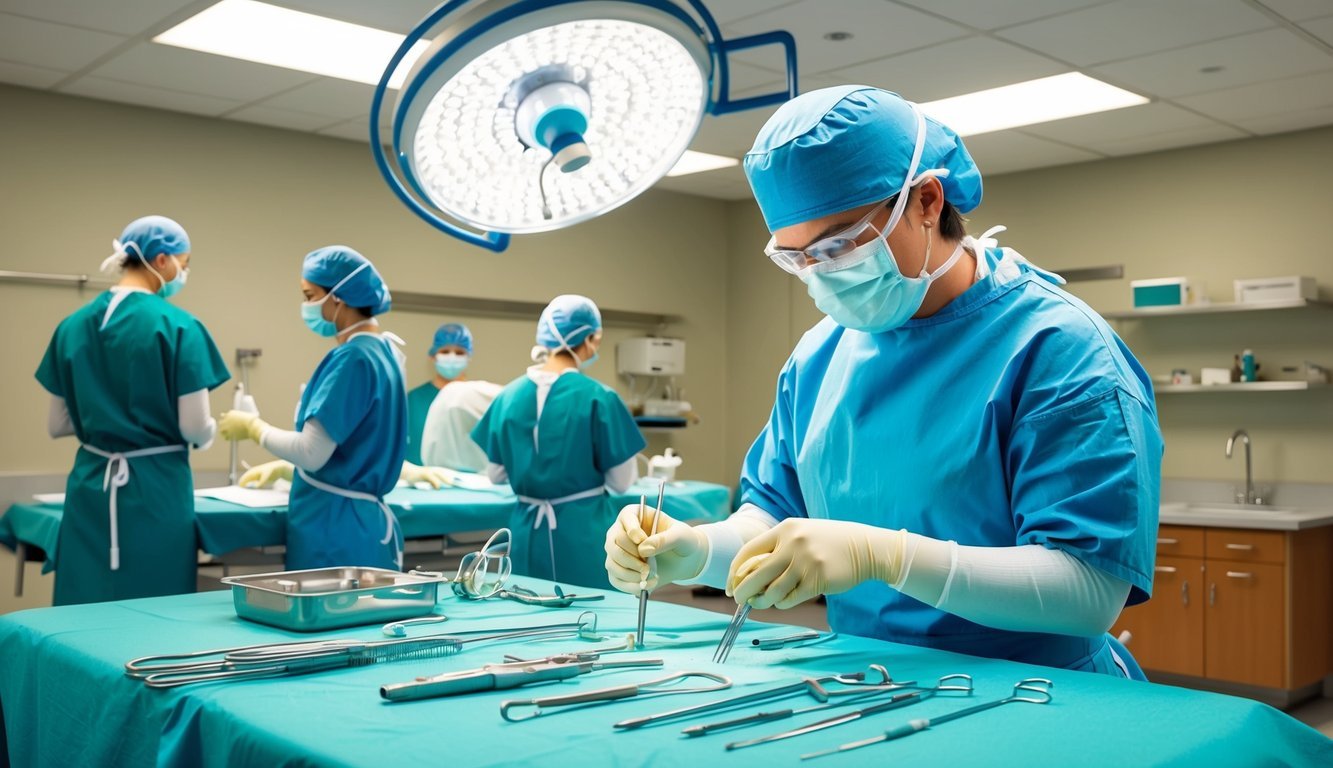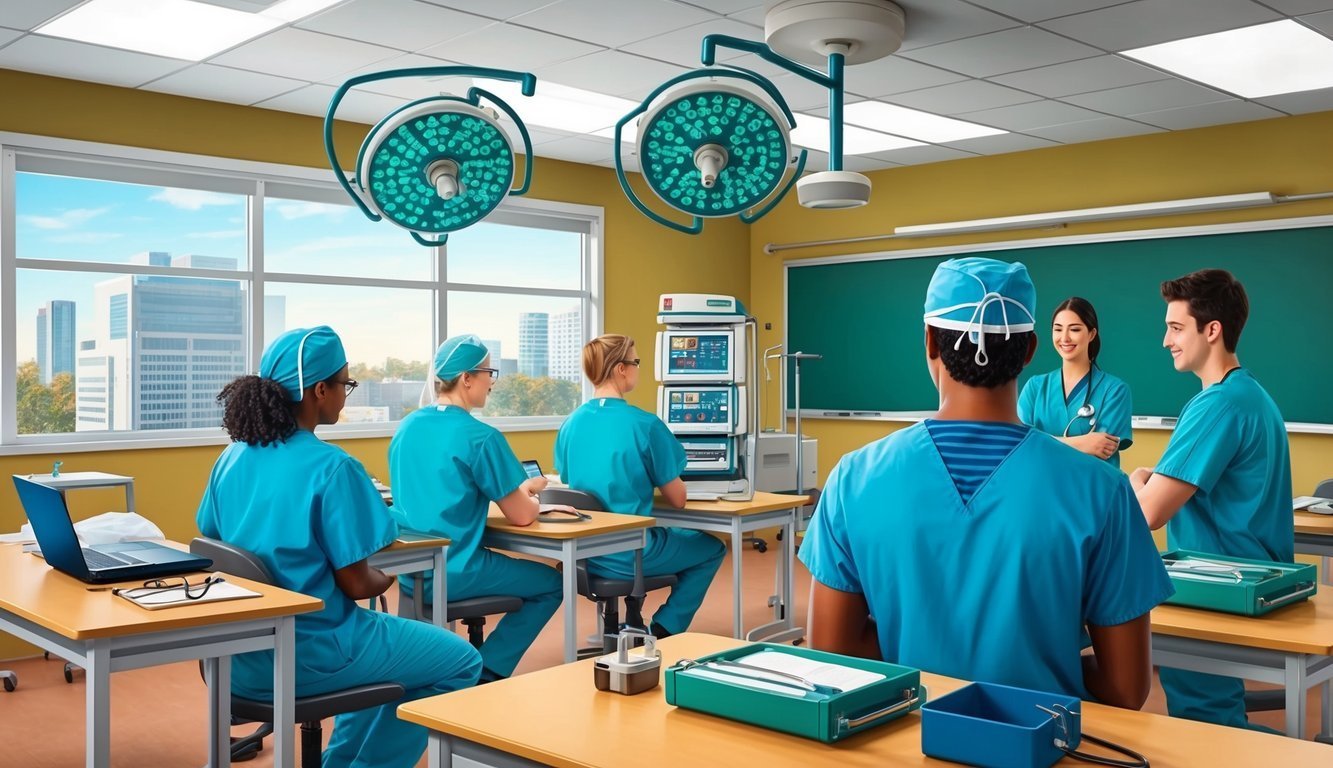Choosing the right school for your surgical technology education is essential for building a successful career as a surgical technologist.
Many programs offer comprehensive training that prepares you for the demands of the operating room, combining theoretical knowledge with practical skills.
Understanding what these programs entail can significantly influence your career trajectory in healthcare.
When exploring schools with surgical tech programs, you will find an array of options, including community colleges and technical schools that provide targeted training.
These programs typically cover core subjects such as anatomy, medical ethics, and surgical procedures, ensuring you are well-equipped for your role in the surgical team.
Look for institutions that are accredited by organizations like ABHES or CAAHEP to ensure the quality of your education.
As you consider your options, researching schools that have strong clinical partnerships can also enhance your hands-on learning experience.
Finding a program with well-structured internships and favorable student-to-faculty ratios can further prepare you for the high-pressure environment of the operating room.
For more insight on top programs, you can explore resources like Nurse.org or Niche.
Surgical Tech Education Basics

Understanding the foundations of surgical tech education is essential for anyone considering a career in this field.
Key factors include accreditation, curriculum components, and the differences between degree types.
Below are the critical aspects of surgical tech programs.
Accreditation by CAAHEP and ABHES
Accreditation holds significant importance in surgical tech education.
Programs are typically accredited by either the Commission on Accreditation of Allied Health Education Programs (CAAHEP) or the Accrediting Bureau of Health Education Schools (ABHES).
Benefits of attending an accredited program:
- Eligibility to sit for the Certified Surgical Technologist (CST) exam.
- Assurance of quality education that meets industry standards.
- Increased employment opportunities post-graduation.
Ensure that the program you choose is accredited to enhance your career prospects and to receive recognized training.
Curriculum Overview
The curriculum for surgical tech programs is designed to equip you with both theoretical knowledge and practical skills.
Core subjects generally include:
- Basic Sciences: Anatomy and physiology, microbiology, and pharmacology.
- Medical Terminology: Understanding technical language used in the medical field.
- Clinical Skills: Hands-on training through clinical rotations in real healthcare settings.
The training typically blends classroom learning with practical applications to foster comprehensive skill development.
This ensures you are well-prepared for the challenges of working in the operating room.
Associates vs Certificate Programs
When considering surgical tech education, you may choose between an associate degree and a certificate program.
Both have distinct features:
| Program Type | Duration | Curriculum Focus | Career Opportunities |
|---|---|---|---|
| Associate Degree | 2 years | Comprehensive, including advanced courses | Broader roles in healthcare |
| Certificate Program | 1 year or less | Intensive, focused training | Entry-level positions |
An associate degree typically offers a more extensive education, including general education courses, while certificate programs provide a quicker path to entering the workforce.
Assess your career goals to determine the most suitable option for you.
Becoming a Certified Surgical Technologist
Becoming a Certified Surgical Technologist (CST) involves fulfilling specific eligibility requirements and successfully passing a national certification exam.
Continuing education is crucial for career advancement and maintaining your certification.
Eligibility and Examination
To be eligible for the CST certification exam, you must complete an accredited surgical technology program.
Programs accredited by the Accrediting Bureau of Health Education Schools (ABHES) or the Commission on Accreditation of Allied Health Education Programs (CAAHEP) are recognized by the National Board of Surgical Technology and Surgical Assisting (NBSTSA).
The certification exam consists of 175 multiple-choice questions, covering various surgical procedures, safety protocols, and instruments.
You can review the application process and fees on the NBSTSA website.
Here’s a quick overview of the steps:
| Step | Description |
|---|---|
| 1. Complete an accredited program | Obtain your degree or certificate |
| 2. Apply for the exam | Submit your application to NBSTSA |
| 3. Pass the certification exam | Score at least 390 out of 750 |
| 4. Maintain certification | Complete continuing education credits |
Continual Education and Advancement
After becoming certified, you need to maintain your CST status.
You are required to complete 60 continuing education credits every four years.
This ongoing education keeps you updated on the latest surgical techniques and technologies.
To enhance your career, consider pursuing specialized certifications in areas like surgical first assisting or specialized surgical procedures.
These credentials can open doors to leadership roles or specialized positions within the operating room.
You can find numerous opportunities for continuing education through organizations like the Association of Surgical Technologists (AST).
Engaging in workshops, conferences, and online courses can help you stay current and advance in your career.
Surgical Technologist Roles and Environment

Surgical technologists play essential roles in various healthcare settings, particularly in operating rooms and outpatient care centers.
Their responsibilities ensure patient safety and the efficiency of surgical procedures.
Understanding the specific environments and functions of surgical technologists is critical for those interested in this career.
Operating Room Functions
In the operating room, surgical technologists are integral members of the surgical team.
You assist by preparing the sterile environment and ensuring all necessary instruments are available.
Familiarity with aseptic technique is crucial, as it prevents infections during surgeries.
Your tasks include:
- Setting up surgical instruments and supplies before the procedure begins.
- Maintaining a sterile field throughout the operation.
- Assisting surgeons by passing instruments and anticipating their needs.
- Counting instruments and sponges to ensure nothing is left inside the patient.
Your attention to detail and understanding of operating room techniques greatly contribute to patient safety and successful surgical outcomes.
Outpatient Care Centers and Hospitals
Surgical technologists also work in outpatient care centers and hospitals, where the focus is on same-day surgical procedures.
In these settings, your role may include preparing patients for surgery before they are taken to the operating room.
Key responsibilities in outpatient care include:
- Conducting preoperative assessments and ensuring patient comfort.
- Explaining procedures to patients, helping alleviate any anxieties.
- Ensuring that all equipment is functioning properly prior to surgery.
Additionally, you may assist in post-operative care by helping patients recover and preparing them for discharge, providing vital support in these fast-paced environments.
Role of Scrub Tech in Patient Care
As a scrub tech, you specialize in maintaining the sterile environment during surgical procedures.
Your expertise in patient care goes beyond the operating room, as you collaborate closely with other healthcare professionals.
Your responsibilities as a scrub tech involve:
- Monitoring the patient’s condition throughout the operation.
- Collaborating with surgical first assistants in positioning and preparing the patient.
- Ensuring necessary supplies are within reach and properly organized.
A well-trained scrub tech is pivotal in optimizing the workflow within the operating room, directly impacting patient outcomes and the efficiency of the entire surgical process.
The Job Market and Career Prospects
The job market for surgical technologists is expanding, driven by the increasing demand for healthcare services.
This growth offers promising career prospects and competitive salaries for individuals entering this field.
Surgical Tech Salary Insights
The salary for surgical technologists varies based on experience, location, and the type of healthcare facility.
According to the Bureau of Labor Statistics, the median annual salary for surgical techs is approximately $48,530.
The highest 10% earn around $75,940 or more.
Experience significantly influences earnings.
For instance, entry-level surgical techs with less than a year of experience can expect around $20.22 per hour, while those with 1 to 4 years may see an increase to $24.21 hourly.
Many surgical technologists pursue certifications to enhance their earning potential.
The Certified Surgical Technologist (CST) credential often leads to better job opportunities and salaries.
Employment Opportunities
Employment opportunities for surgical techs are projected to grow by 7% from 2021 to 2031, much faster than the average for all occupations.
Hospitals remain the largest employers, but you may also find roles in outpatient surgical centers, physicians’ offices, and educational institutions.
As the healthcare environment evolves, the need for skilled surgical technologists will increase.
You may work closely with surgeons, nurses, and other healthcare professionals, playing a vital role in patient care during surgeries.
To find suitable positions, consider checking platforms such as Nurse.org for job postings and resources.
Geographic Variance in Demand
Geographic location plays a crucial role in job opportunities and salary for surgical technologists.
States like California, Texas, and Florida typically offer more positions due to their larger healthcare systems.
In areas with fewer healthcare facilities, job availability may be limited.
For instance, surgical techs in metropolitan areas can expect higher salaries and more job choices compared to rural locations.
Consider researching specific regions for a clearer picture of local job markets.
Websites like Trade Schools and state job boards can provide valuable insights into geographic demand and average salaries in your area.
Selecting the Right Surgical Tech Program

Choosing a surgical tech program involves careful consideration of multiple factors.
You need to evaluate costs, acceptance rates, and whether an online or on-campus option suits your lifestyle and learning preferences.
Program Costs and Financial Aid
The cost of surgical tech programs can vary significantly depending on the institution and program format.
For example, an Associate of Applied Science in Surgical Technology may range from $10,000 to $30,000.
It’s essential to research financial aid options, including federal grants and scholarships.
Many schools, such as Rasmussen University, offer financial assistance programs.
| Type of Cost | Estimated Range |
|---|---|
| Tuition | $10,000 – $30,000 |
| Books and Supplies | $500 – $1,500 |
| Lab Fees | $500 – $2,000 |
| Total Estimated Cost | $11,000 – $34,500 |
Acceptance Rates and Application Tips
Understanding acceptance rates can help you assess your chances at various schools.
Competitive programs often have lower acceptance rates, while others may accommodate a broader range of applicants.
To enhance your application, focus on your previous academic performance and relevant experience.
Strong references and a well-written personal statement can make a significant impact.
Research schools that align with your goals, such as NYU Langone Health, and verify they are accredited by organizations like ARC/STSA.
Online vs On-Campus Options
When choosing between online and on-campus surgical tech programs, consider your learning style and schedule.
Online programs offer flexibility but may lack hands-on learning experiences, which are crucial for surgical technologists.
On-campus programs typically provide more direct access to labs and clinical externships, allowing for practical experience in a supervised environment.
Ensure the program you select includes a robust clinical component for effective training.

